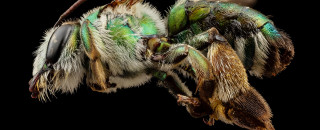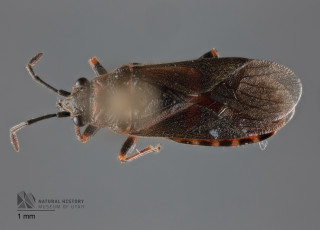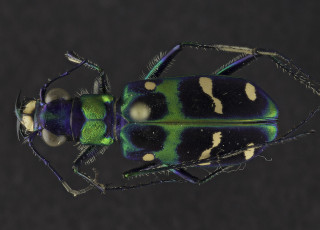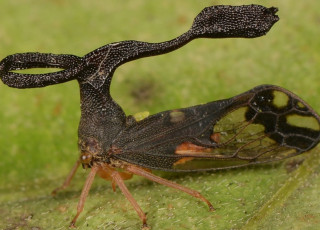Bee Diversity – Beyond the Honeybee
By Michael Mozdy
Ctenocolletes smaragdinus, a green burrowing bee found in Western Australia. Image by Sam Droege, part of the USGS Bee Inventory and Monitoring Lab’s photography collection, public domain..
For many of us, the honeybee is representative of bees as a whole – you know, the kind that people keep in their back yards in white frames to make their own honey. Our familiarity makes sense; honey has been an important sweetener and source of calories for millennia.
But the honeybee is by no means demonstrative of bee diversity. It’s not even native to Utah.
NHMU Invertebrate Collections Manager, Christy Bills, emphasizes this point: “To paraphrase my USU colleague, Joe Wilson, saying you want to protect honey bees in order to preserve bee diversity is like protecting chickens because you really care about bird diversity.” In other words, honey bees and chickens might be important aspects of human agriculture, but they are extremely specialized and not representative of native diversity.
Utah, in particular, is a cornucopia of bee diversity, boasting around 1,100 species in the state. Southern Utah alone has approximately the same number of bee species as the entire eastern U.S. coast.1
“Some Utah bees are really tiny and some are big – they come in many shapes and colors, too,” notes Bills. She points out a few other facts common to all bees:
Bees are all pollinators
“Some are generalists, visiting lots of different types of flowers, but some are specific, like your friends who can only eat a few foods,” Bills explains, “and they essentially only feed on one flower.” In protecting the diversity of bees, it is important to understand the relationships they have with local plants so that we can preserve both the plant and the bee.
Only female bees have stingers
Some species of bees have evolved to have no stingers at all, even the females. What’s more, the vast majority of bees are not aggressive and will only sting if they feel their nest is being threatened. Wasps, yellow jackets, and hornets are another story, of course!
Not all bees produce honey
In fact, less than 4% of the 20,000 known species of bees produce honey. While all of them use pollen and nectar from flowers as a food source, only the honey bee makes the big store of honey in their hives. Many other bees like carpenter bees, digger bees, and cuckoo bees only gather enough pollen and/or nectar to feed themselves day-to-day.
The hive is the exception; solitary burrows are much more common
“The holes you might see, especially in Utah’s vast desert lands, are mama bees making a nest,” explains Bills. The mother might laying eggs in straw, soil, or dried plant material like a hollow twig. On the other hand, “cohabitation in a nest is a story of specialist behavior and certainly not representative of bees as a whole,” she notes.
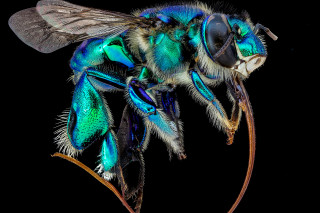
Euglossa imperialis, a shiny orchid bee from Costa Rica. Note the extra long tongue that enables it to suck nectar from deep flowers, into which other bees might not be able to reach. Image by Sam Droege, part of the USGS Bee Inventory and Monitoring Lab’s photography collection, public domain.
There is a lot to learn and admire about the diversity of bees. In fact, other insects have evolved to mimic bees because predators will avoid them (and the chance of getting stung). You might be familiar with bee flies (which don’t sting, incidentally) and the snowberry clearwing moth is a spectacular bumblebee mimic.
“I encourage people to be outside with their eyes open and to be curious,” says Bills. “I recently saw some tiny fairy bees [Perdita] on some alfalfa and some wool carder bees gathering up the lamb’s ear plant leaves for their burrows.”
The Natural History Museum of Utah has spectacular historical collections of insects in Utah, including bees. Below are some examples of the fine bee photography catalogued by the Invertebrate Collections team.
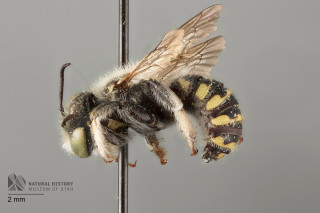
The wool carder bee – this specimen dates back to 1946, collected in Salt Lake City. © NHMU
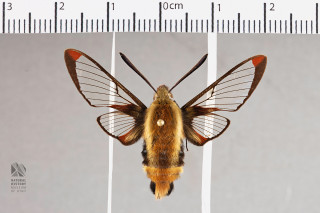
Dorsal view of the Snowberry Clearwing Moth, a bumblebee mimic. © NHMU
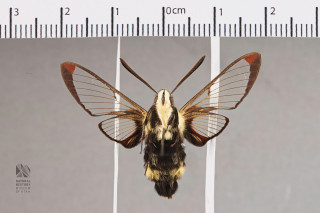
Ventral view of the Snowberry Clearwing Moth, a bumblebee mimic.
© NHMU
If you have more questions about bees, be sure to join us at NHMU for our annual BUGfest!
1 Utah State University Extension, Beginner’s Guide to Common Native Bees.
